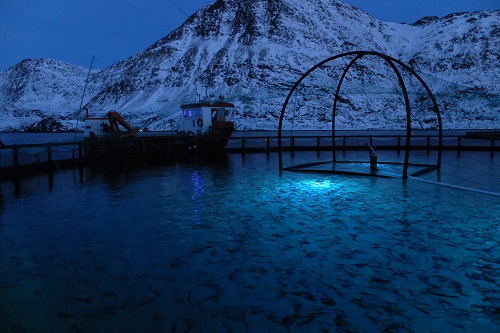LED lighting not only supports and optimize the growth of plants, it can also help fish farming. Signify announced its latest innovation in aquaculture LED lighting with related product that improve land- and marine-based cultivation of salmon, seabass and seabream. The unique light distribution also lead to less exposure to sea lice, reducing treatment up to 50%.
According to Signify, light is a powerful tool for enhancing fish production and welfare. With an optimized contrast ratio, Philips aquaculture LED lighting supports a lower food conversion ratio and the right light distribution helps to prevent sea lice exposure. With smooth ramp up and low dim levels it also reduces stress levels for the fish, improving their welfare. The light spectrum is optimized for the distribution under water, the eye sensitivity of the fish and the pineal gland photoreceptors, maximizing the contribution towards growth at their best without maturing. Salmon are kept in a perpetual state of summer to prevent spawning and maintaining great taste and texture in the on-growing stage.

(Image: Signify)
Unique in its kind is the light distribution, singly directed downwards in the seacages or tanks. The optimized light density in combination with the downward light beam ensures that the fish will swim deeper. And when installed below 5 meters, it reduces the need for sealice treatments as the fish will mostly swim below the sealice belt. This also lower the amount of electricity that is used and ensures that there’s no light pollution created. In tanks, the light distribution addresses the need for lighting in every part of the tank ensuring light can reach where it needs to reach, without the fish or tiny particles obscuring the light.
Growing salmon with a high market value at low operational costs while maintaining constant production levels, is challenging. In Norwegian farmed salmon, delousing accounts for up to 10% of production cost. And, with fish feed making up 50% of operational costs, any reduction in food conversion ratio will result in more profit.
Philips aquaculture lighting combines the latest LED technology with research expertise in fish physiology. Signify collaborates with leading universities and institutes by funding PhD and post-doctoral research projects. This includes research into on-growing at Stirling University, Scotland, and research into the effects of light spectrum, uniformity, intensity and dimming on salmon in the hatchery stages at Bergen University in Norway. The research findings show that the lighting helps to avoid stress in fish resulting in a 15% reduction in mortality from the hatchery to on-growing stage.












